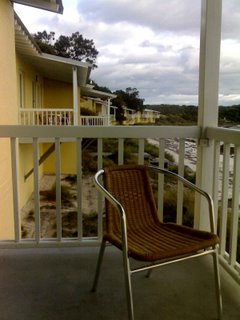
A regular Rotto Bloggo reader was flicking through pages of 'The Architect', the journal of the Royal Australian Institute of Architects (WA Chapter) and was thrilled to see an architectural retrospective on the waterfront cottages on Thomson, Geordie and Longreach Bays.
Being an architectural journal, the writing (by Simon Anderson at UWA)
Is, of course, quite…er…analytical.
Let’s have a look at Simon’s work:
The cottages’ purpose “…was to provide affordable and sustainable holiday housing in both historically sensitive (in the case of Thompson Bay) and environmentally delicate (in the case of Geordie and Longreach Bays) location, and it is hard to argue that they have not been outstandingly successful in these respects.”
Quite right. No argument there, apart from having Thompson instead of Thomson.
“They were built en masse, yet they deliver a level of spatial variety rarely achieved in large scale repetitive residential developments.”
Spatial variety? They have different dimensions, we think that means…
Anyway, as Prof Julius Sumner Miller would’ve asked: how is it so?
“As houses, they are everything that houses are now not. They are indestructibly robust. They are very small but very well planned and very well sectioned for privacy and outdoor amenity. They do not have big front doors, and the front door enters the kitchen…they are generous if you want to eat, talk, sleep, read, go fishing or swimming, but do not offer much in the way of domestic ceremony.”
OK. Not sure how they let you go fishing or swimming, but we’ll let it go through. Much better is this next bit:
“They let you live your life rather than ruling your life. They are successful because they look backwards to earlier times. Is not Perth always supposed to be behind the times? Maybe we should try harder to go backwards?”
And the crowd goes wild! Deafening ovation for Simon!
Then there’s a list of what they don’t do. These include: “They do not countenance the curvilinear, continuous form or the monumental. Instead the use a logic of discrete rectilinearity to respond to the infinite and infinitesimal particularities of place at both macro and micro scales.”
Hmm. We read this several times, tried to work it out with a pencil, set a small fire under it, and made it a martini. But we were no closer to comprehension. Our guess: the straight lines work well.
There’s some talk about how they look different form far away and up close, and then:
“They are successful because of this fractional dimensionality (the term given to objects which exist differently at two or more scales of observation) and pixellated viscerality.”
Pixellated viscerality?
Too much for this simple blogger. But the main message you can take from Simon’s monograph is the cottages are first-class.
Will the cottages in the new Mt Herschel development be as good? Don’t bet on it.
A chair admires the discrete rectilinearity of Thomson Bay cottages.


No comments:
Post a Comment